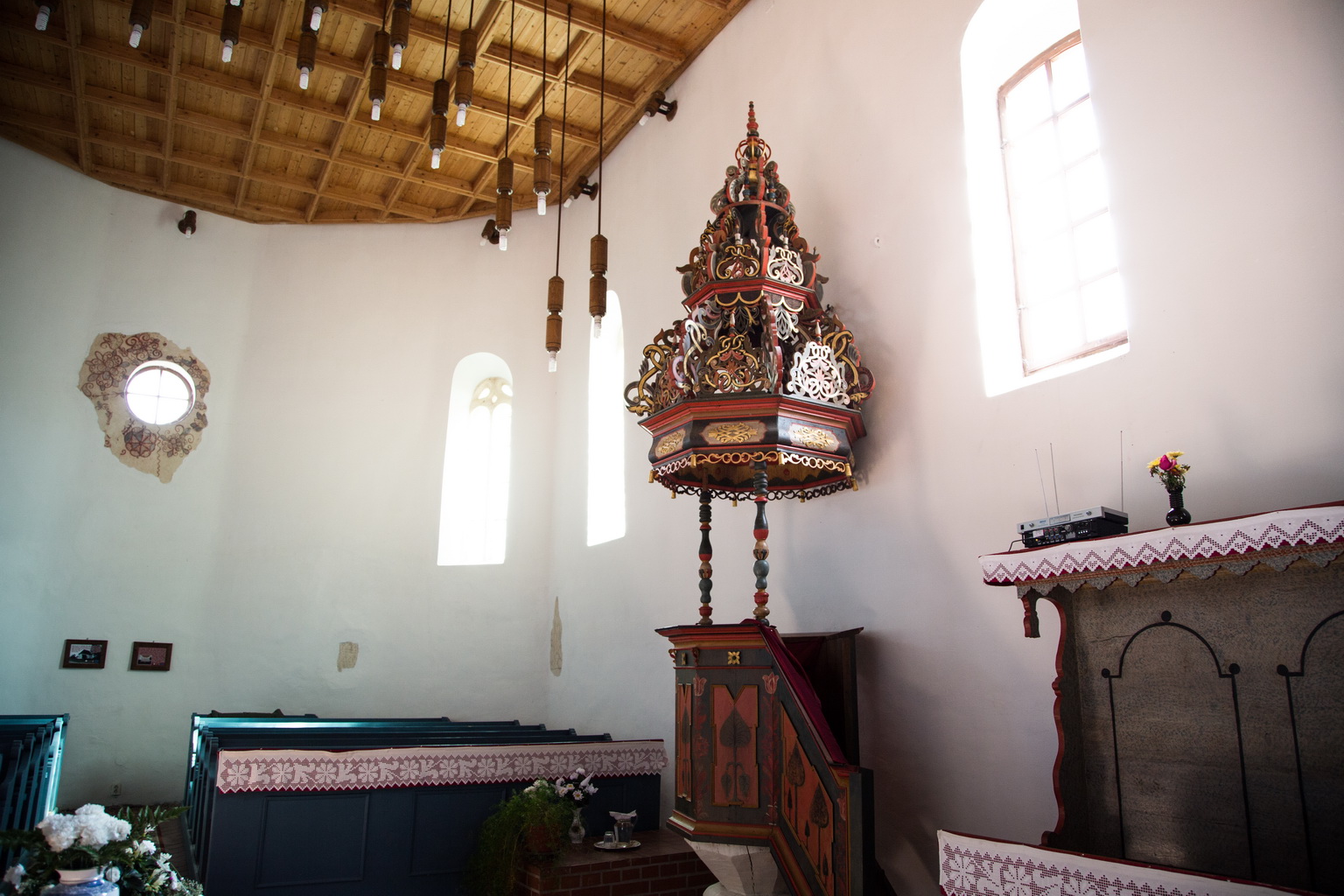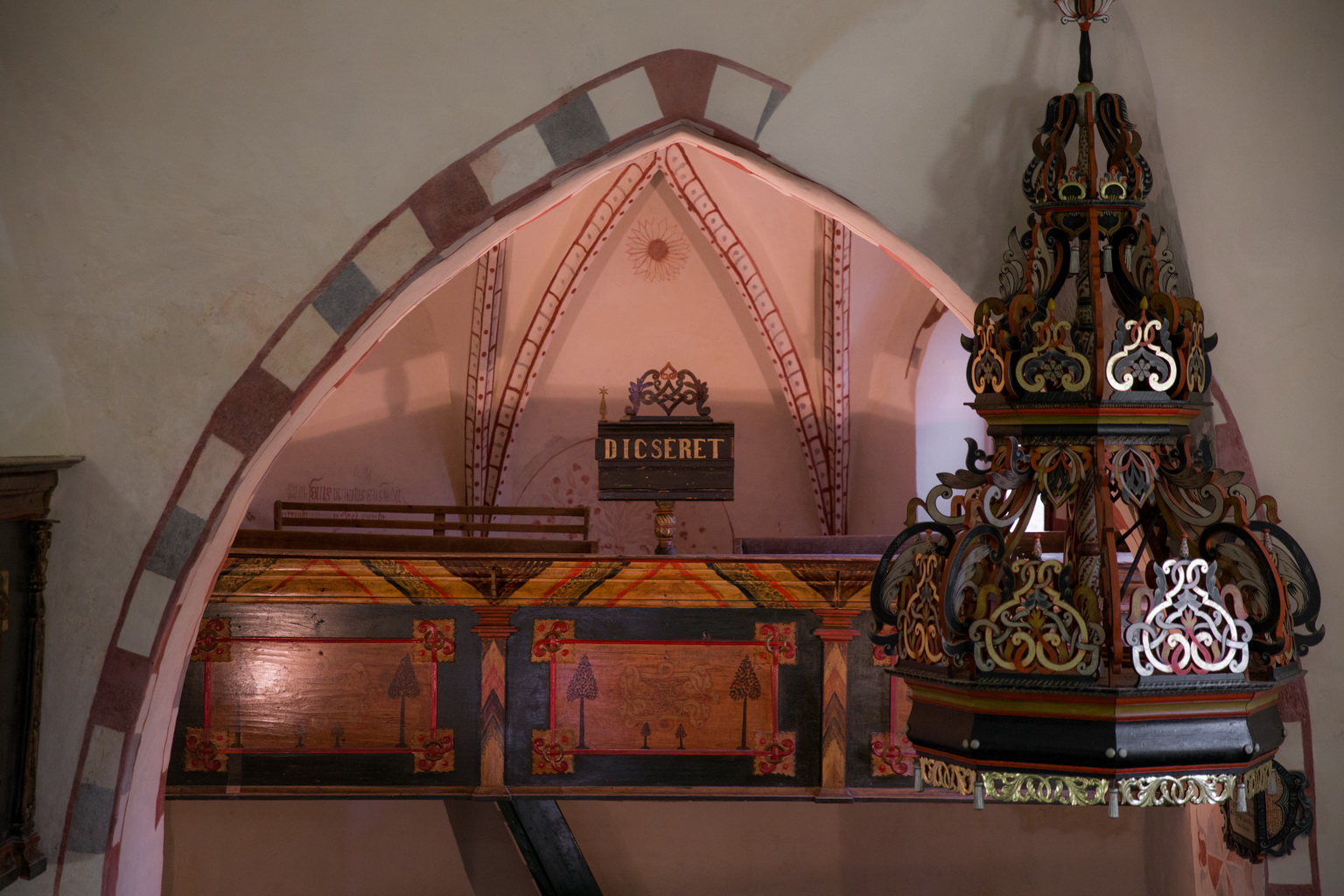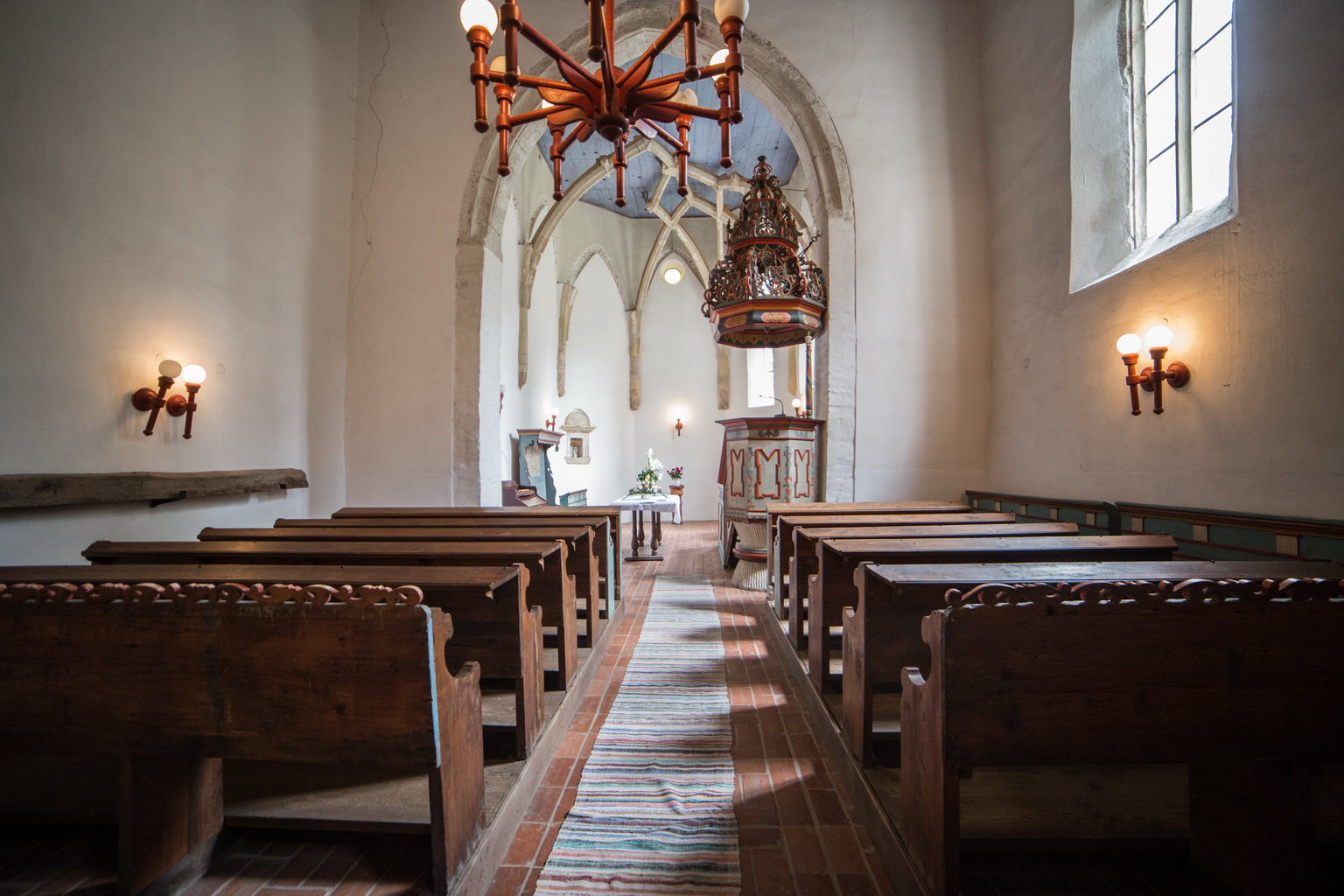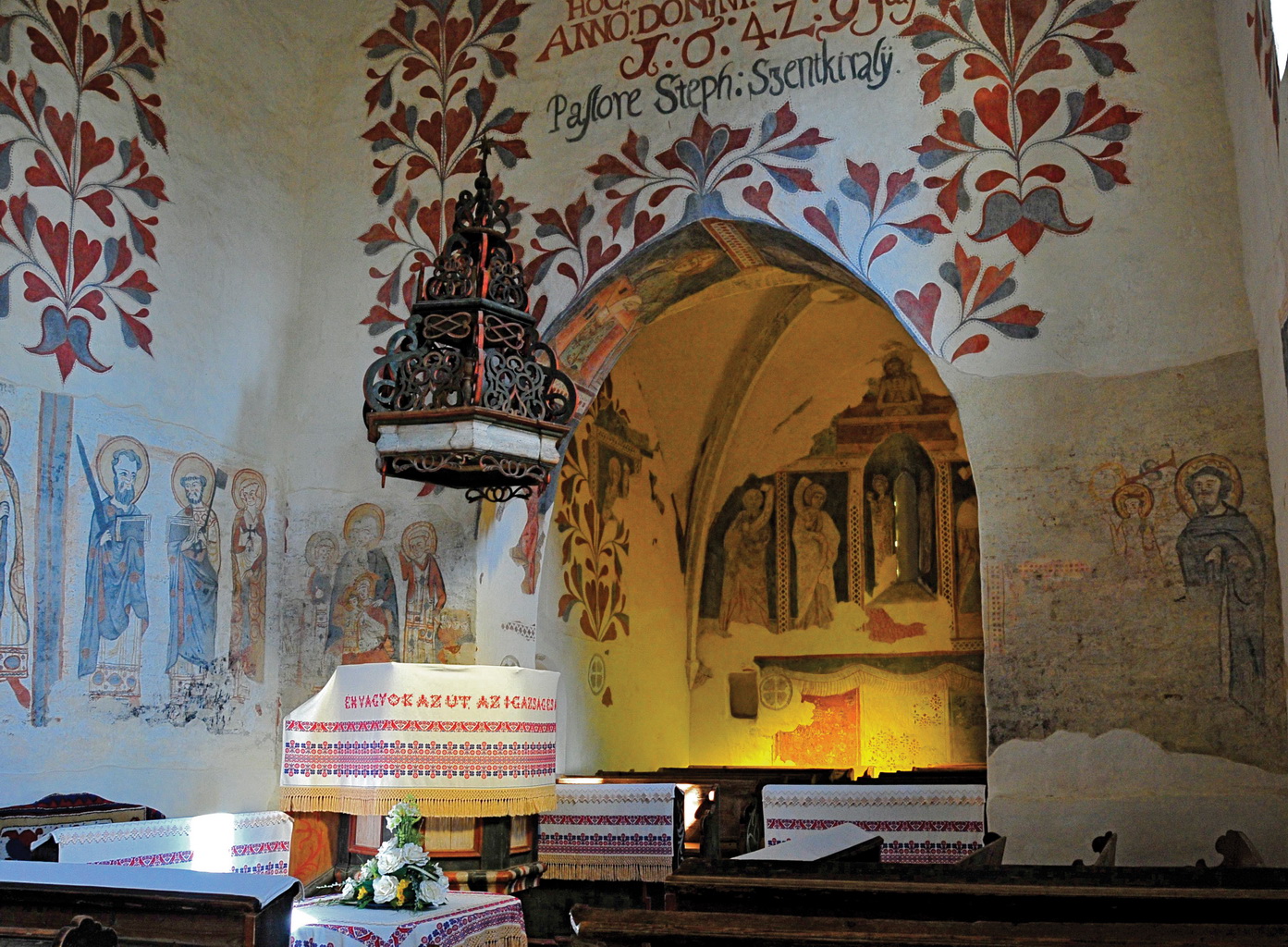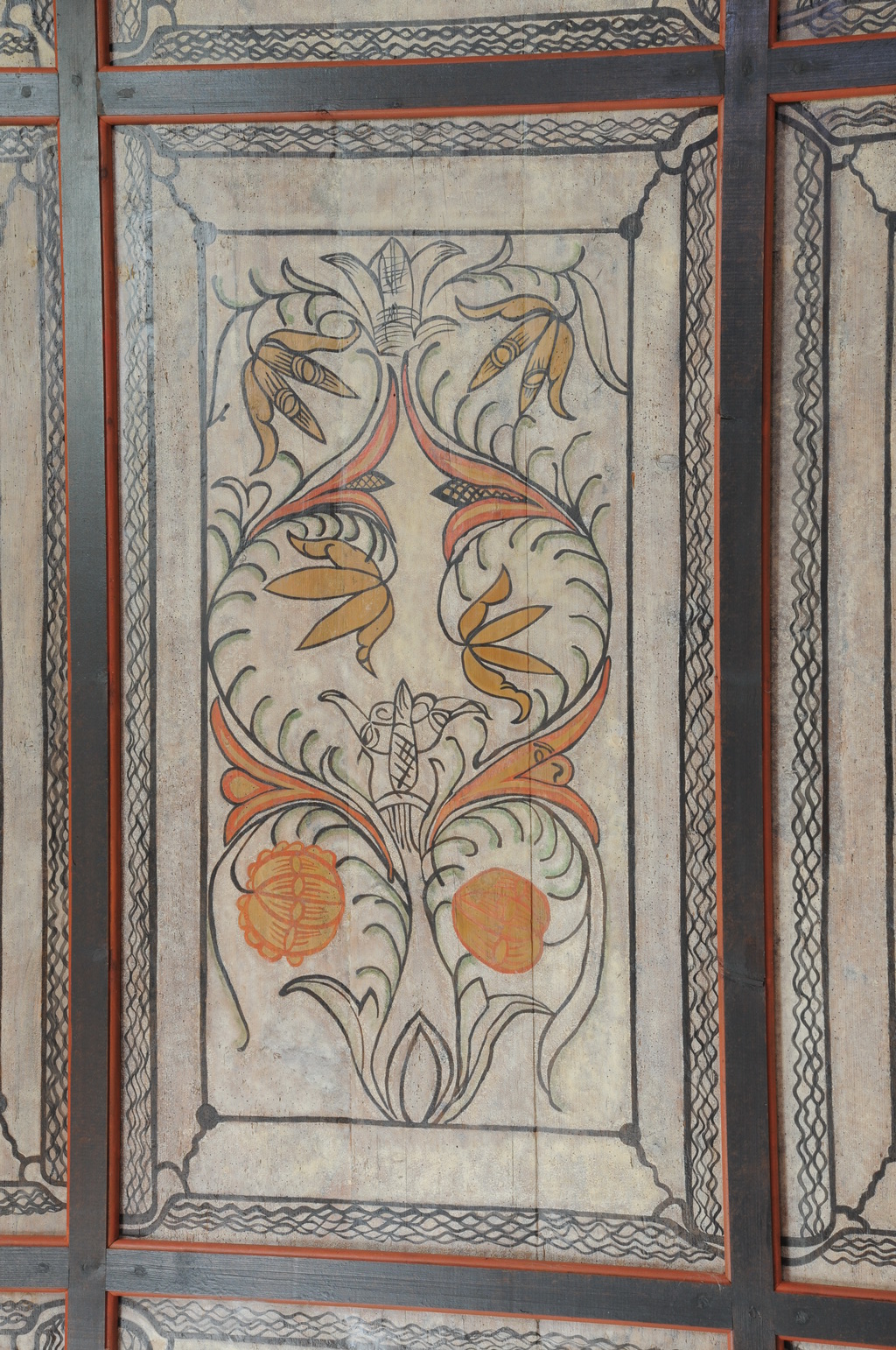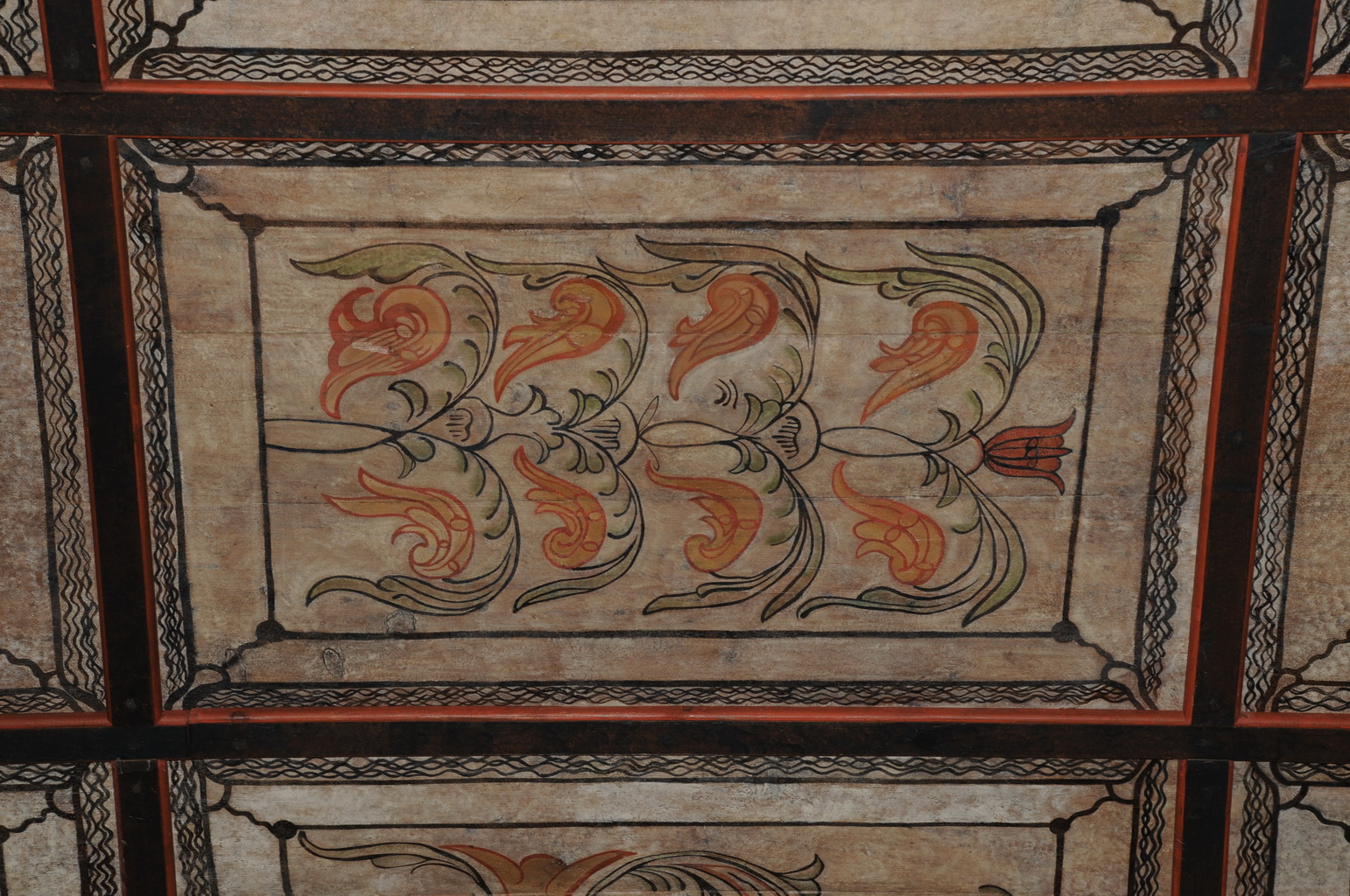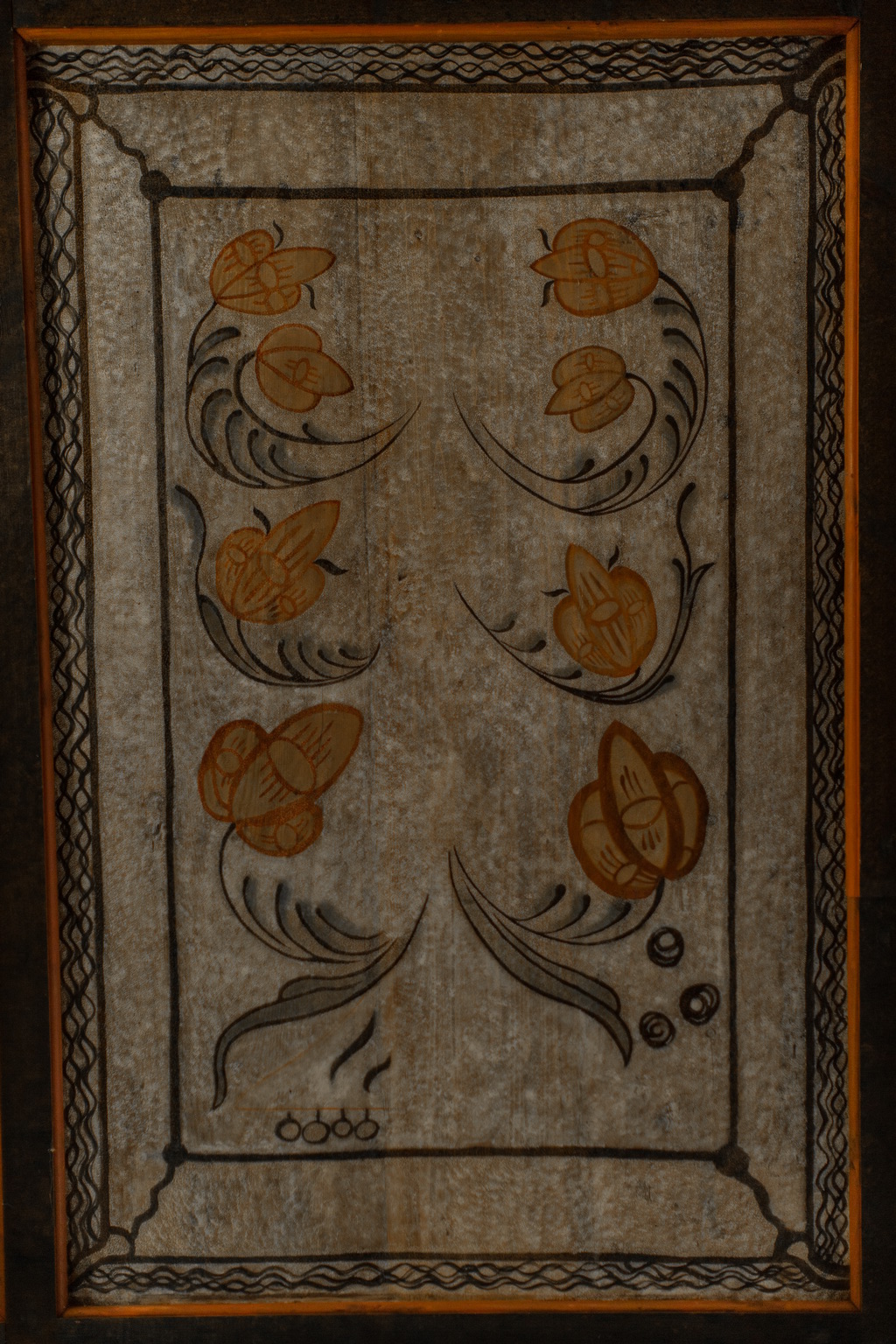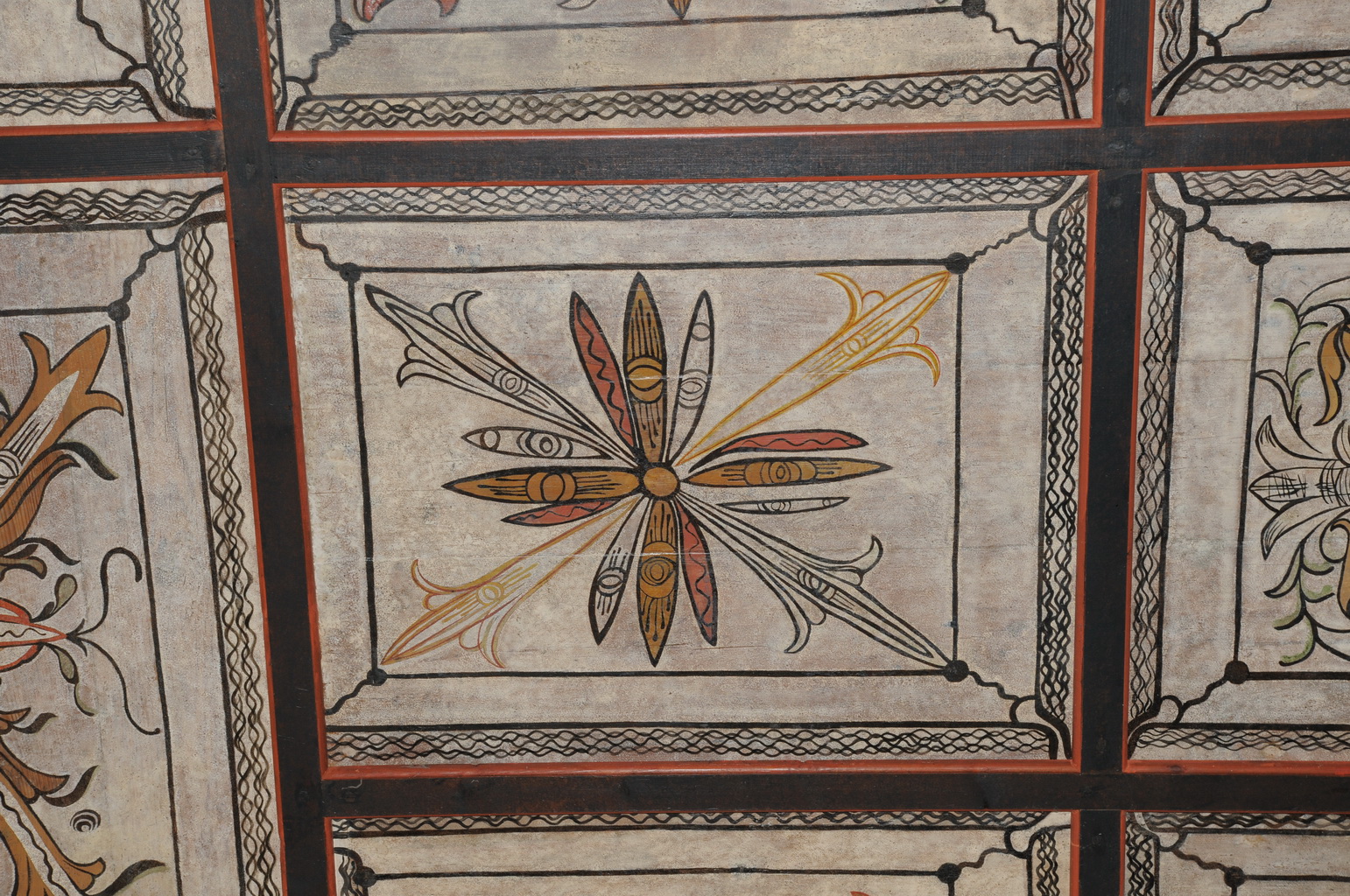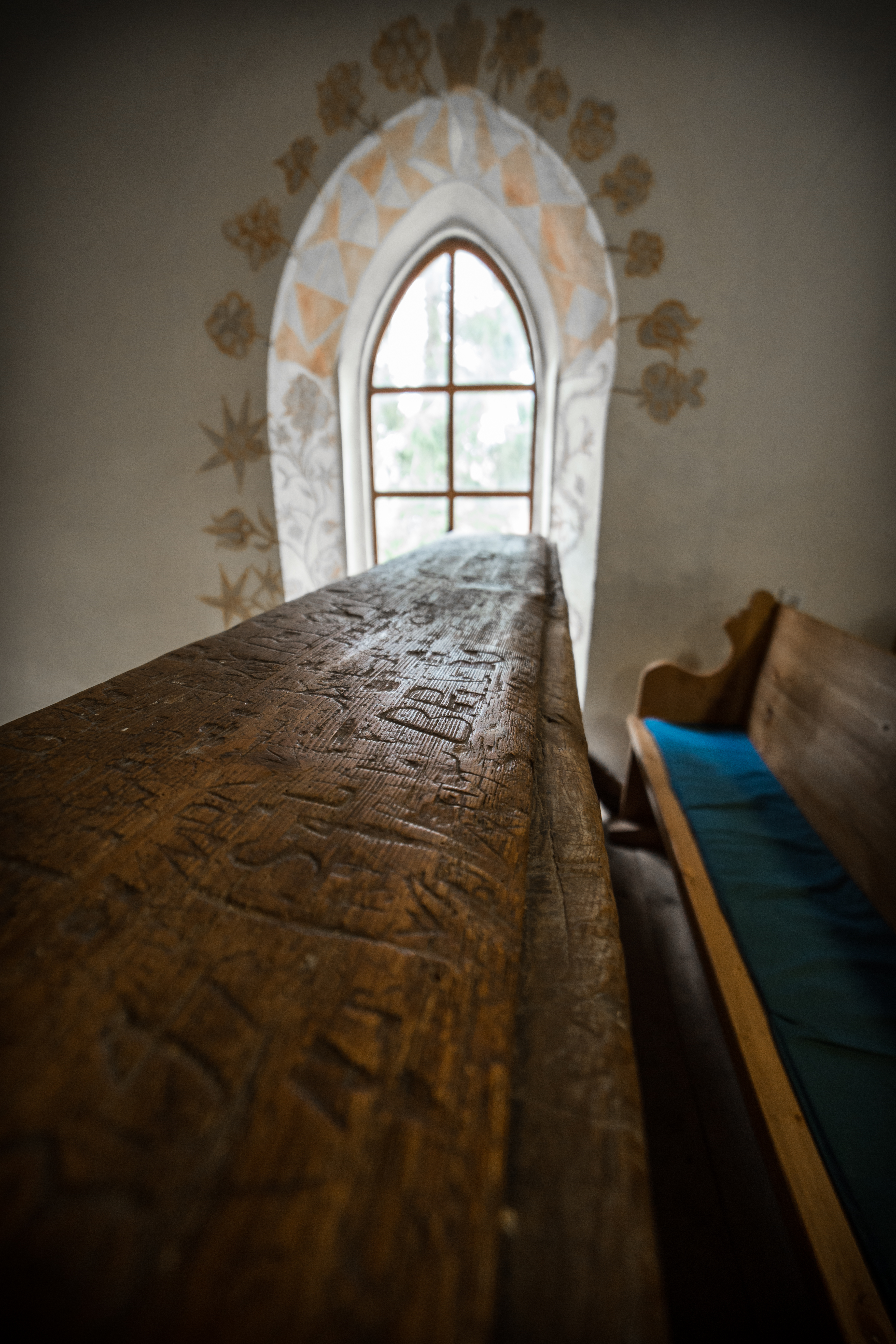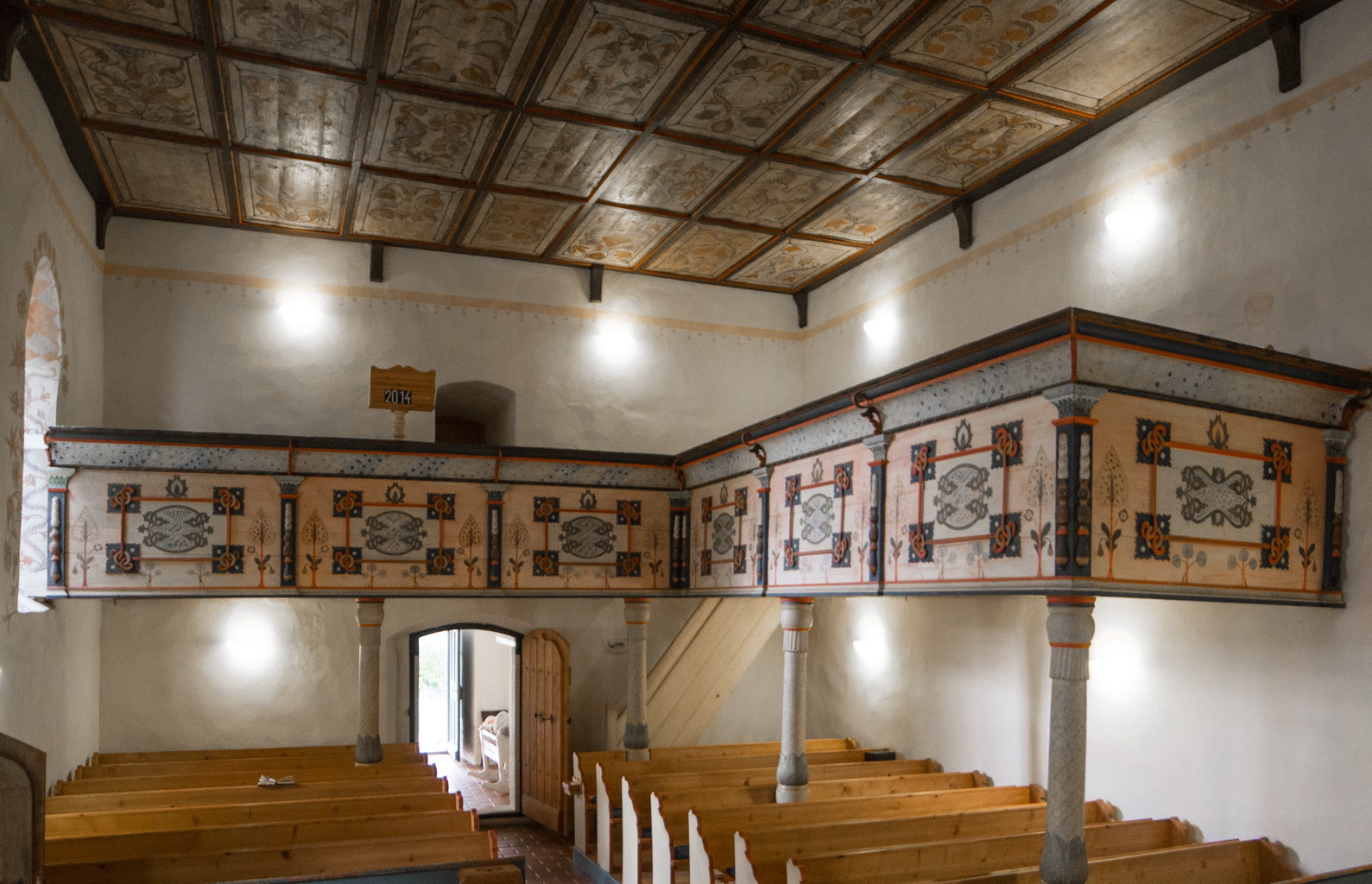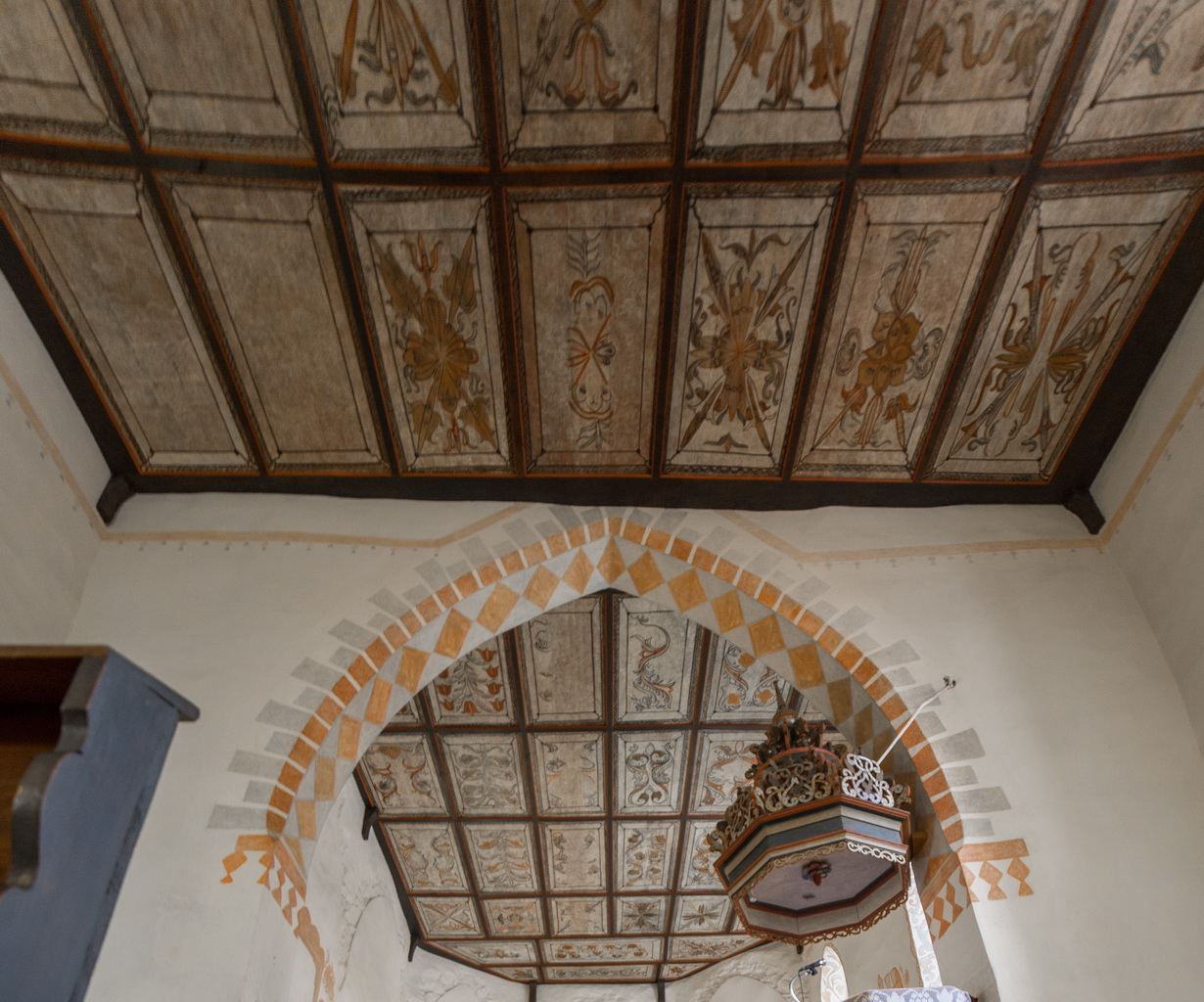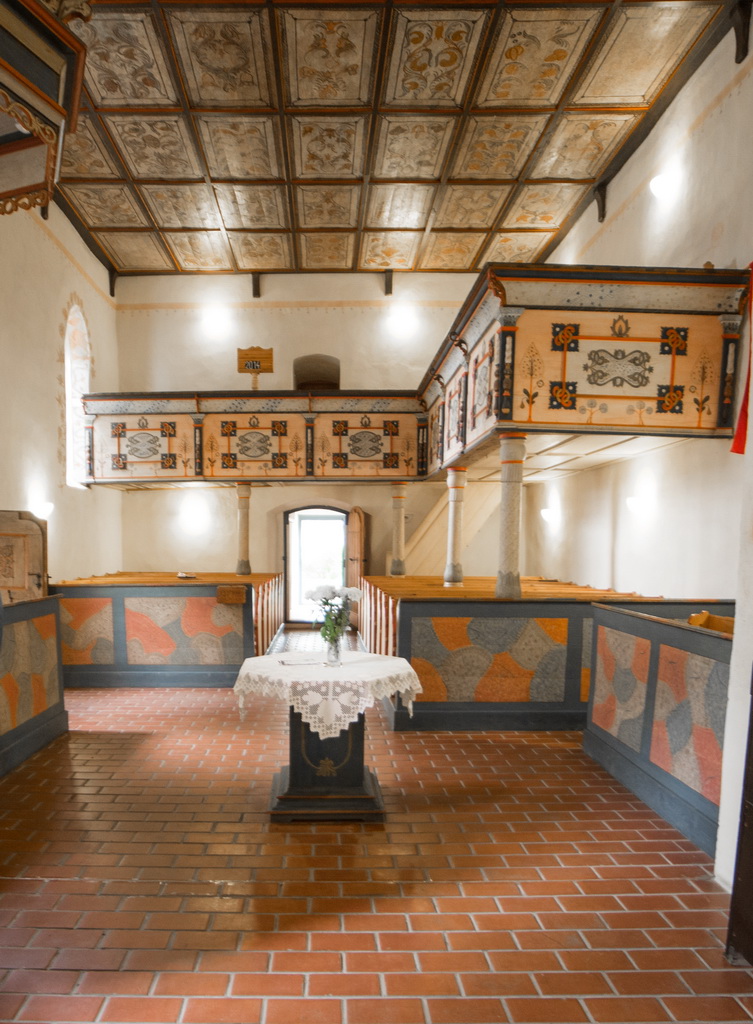A set?
The Lord’s Table, the pulpit, the Chair of Moses, the gallery and the pews are the most significant furnishings of the church. Each of these items was made of wood, and some of their details are very similar not only to one another, but also to the furnishings of other churches in the surroundings. On the basis of these facts, it is very probable that they all were created in the workshop of Gábor Vasvári Ódor, whose name is indicated on the pulpit in Vámosoroszi with the date 1794. The “crown” of the pulpit is smaller in size than that of Vámosoroszi, it features only two levels, but according to its decorative elements and style of painting, it is clear that it is a variation of the same type. It is also true in the cases of the “crowns” of the pulpits in Kisszekeres, Nagyszekeres, Kölcse, Csaroda, Tarpa, Csengersima and Hermánszeg.
The Lord’s Table, the pulpit, the Chair of Moses, the gallery and the pews are the most significant furnishings of the church. Each of these items was made of wood, and some of their details are very similar not only to one another, but also to the furnishings of other churches in the surroundings. On the basis of these facts, it is very probable that they all were created in the workshop of Gábor Vasvári Ódor, whose name is indicated on the pulpit in Vámosoroszi with the date 1794. The “crown” of the pulpit is smaller in size than that of Vámosoroszi, it features only two levels, but according to its decorative elements and style of painting, it is clear that it is a variation of the same type. It is also true in the cases of the “crowns” of the pulpits in Kisszekeres, Nagyszekeres, Kölcse, Csaroda, Tarpa, Csengersima and Hermánszeg.
On the basis of the parallel examples in the surroundings, the creation of the gallery is possible to be connected to this workshop. A common typical characteristic of these galleries is the ornamentation of their breast-shields featuring thin wandering plant-like frames which loop in rings in the corners. Among them, wandering plants with leaves can be observed, which remind us of the sawn ornaments of the pulpit. In Sonkád, following the removal of the previous repaintings, the original coloring can be admired. (Similar galleries: Nagyszekeres, Mánd (Hungarian Open Air Museum, Szentendre), Vámosoroszi, Kölcse, Csaroda, Túrricse, Nagyar, Milota).
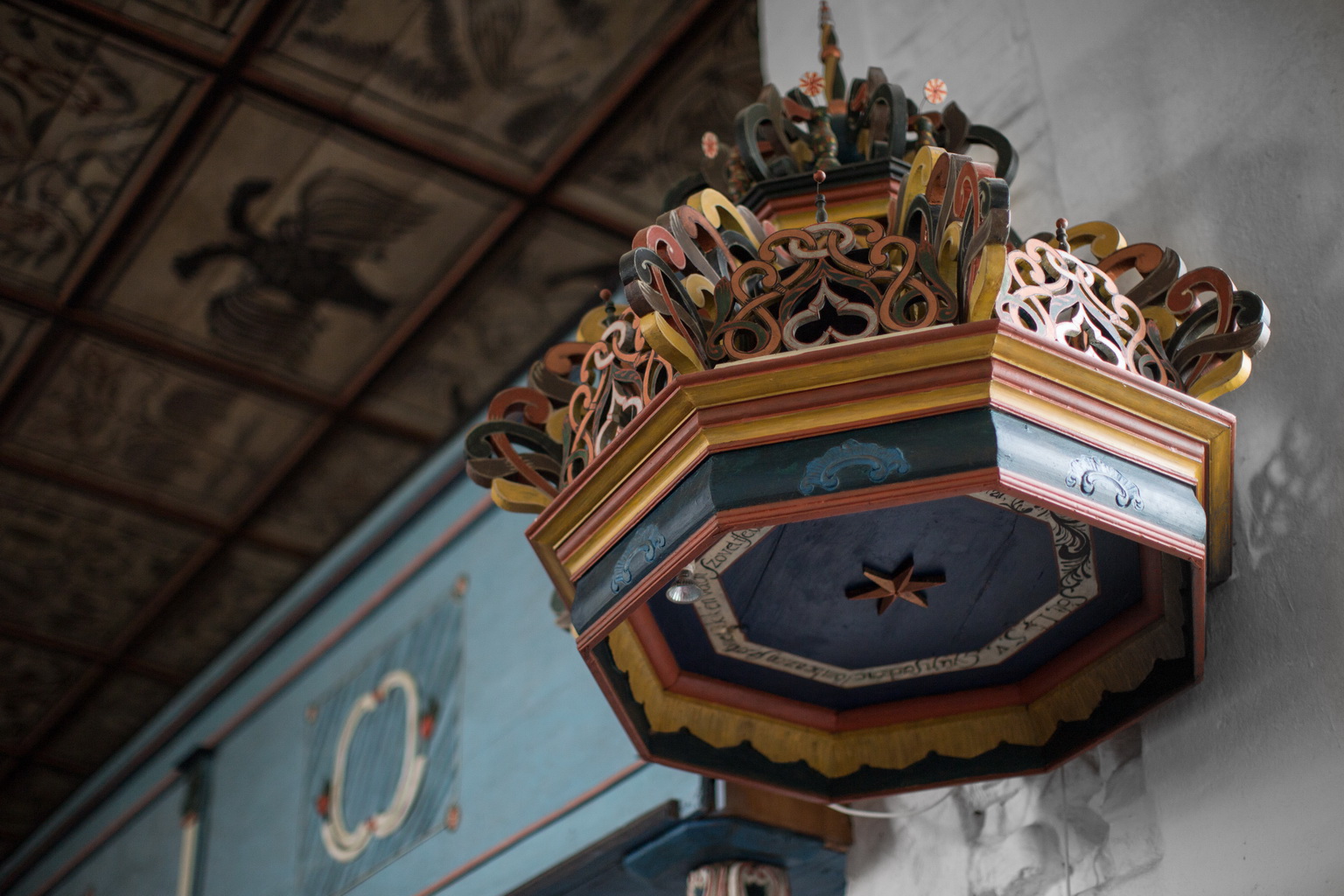 |
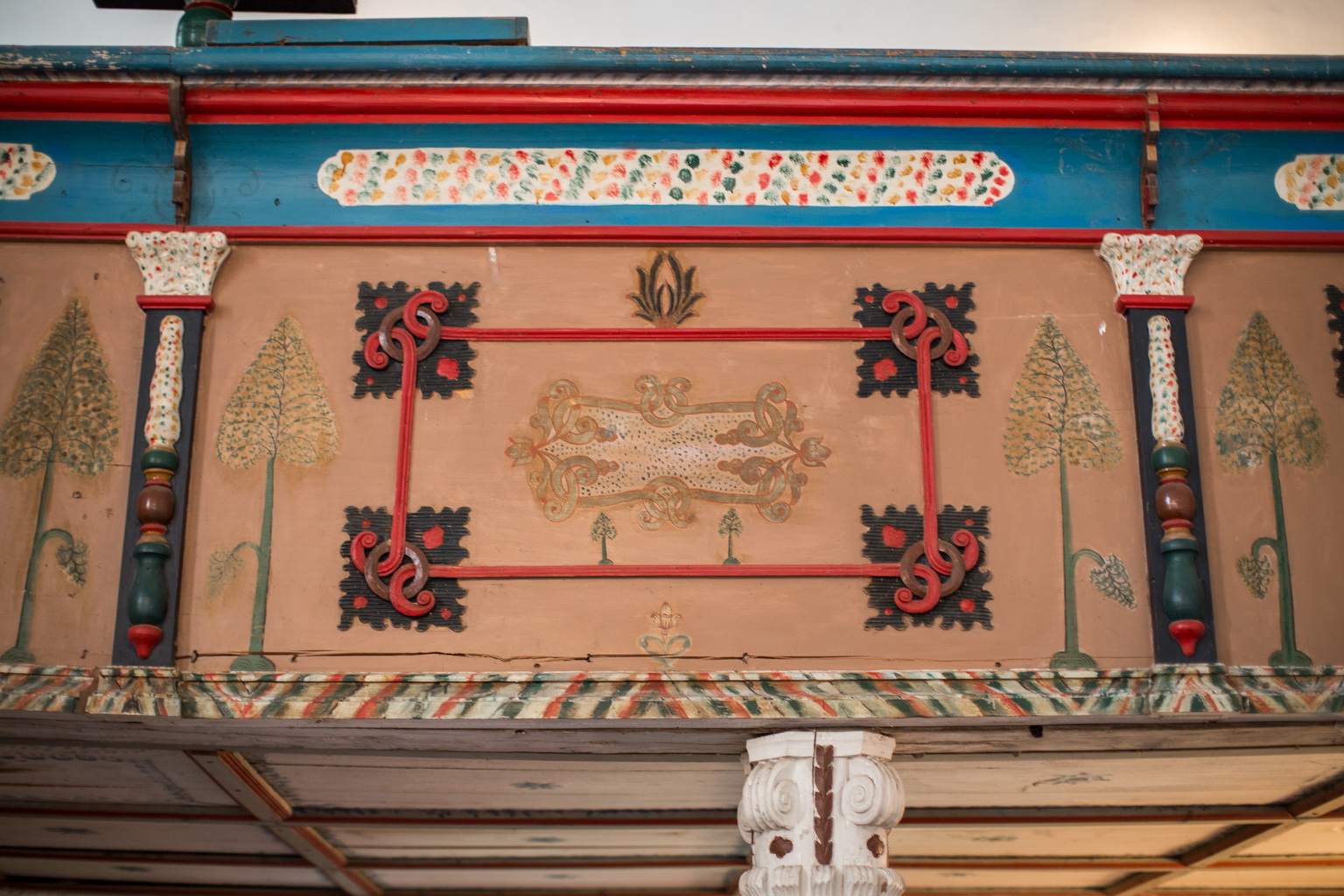 |
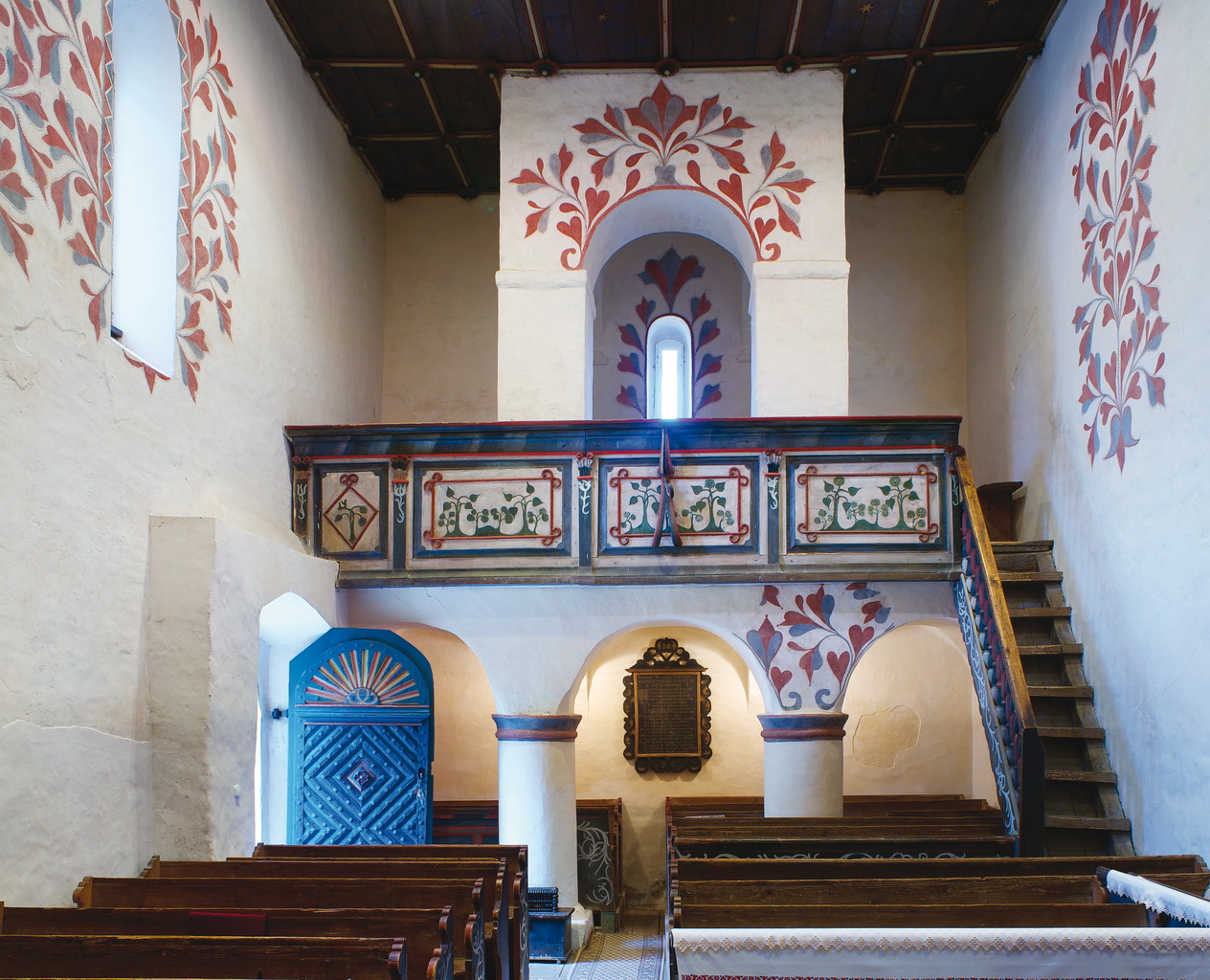 |
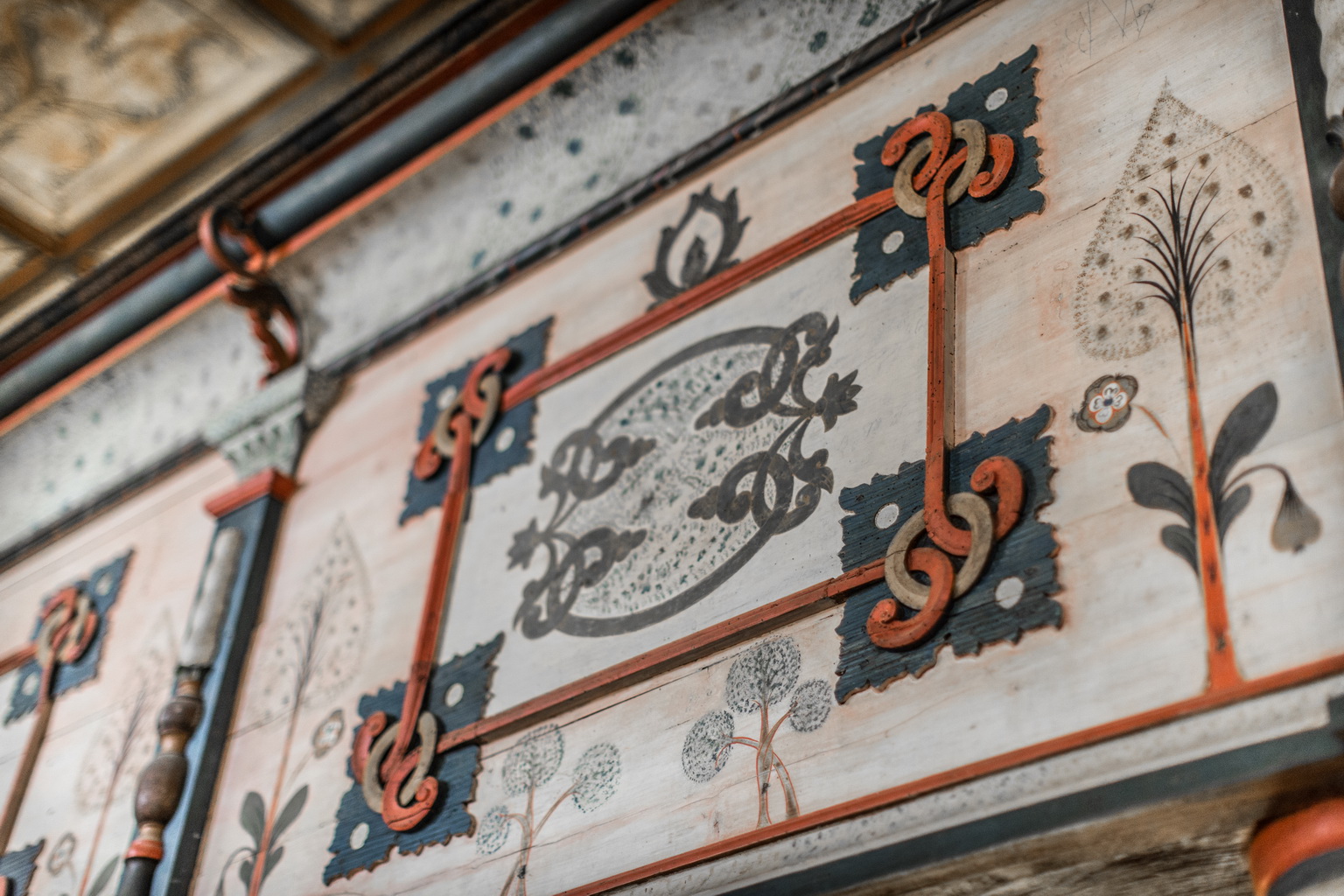 |
|
Csengersima |
Nagyszekeres |
Csaroda |
Sonkád |
Do not believe your eyes!
Each detail of the church in Sonkád has been restored. However, it does not mean that, using the popular expressions, “the church has been restored in its original condition”, or “it shines in its original light”. The situation is not that easy!
For instance, the wooden ceiling appeared from beneath a thick layer of mortar in totally repainted condition.
What happened to them following that?
The boards were removed and transported to a restoration workshop in Budapest where the wood material, which was in very bad condition, was conserved and the decayed elements were supplemented with new ones.
Following that the boards were cleared of contamination and the blue repainting. As a result, some fragments of the 18th century painting appeared. The white base color abraded almost everywhere letting the texture of the boards be visible. In addition, only very small parts of the black contour lines and the red patches could be seen.
On the basis of these fragments, the restorers tried to reconstruct the original lines and painting by supplementing the deficits and making the broken lines continuous. The lines consisting of tiny black points in this picture, are already the results of the retouch during the restoration process while the darker and denser black parts are the fragments of the original. Following the repainting of the contours and the colors, the white base color was also repainted with the application of the same technique.
Finally, the boards were reinstalled in their original places.
The wooden ceiling in Sonkád was preserved in very poor condition, some parts of its painting were fragmented. In many cases, the motifs that it features were only possible to be restored on the basis of the traces that the wood featured. Restoration means reconstruction on the basis of remaining fragments. Due to the complexity of reality, subjective interpretations are inevitably born during this process. And this fact is not hidden by the restorers: the retouch featuring tiny points indicates that we do not see the original painting; where the restorers had no clues, the surface has been left empty.
Look behind the color walls!
We said that efforts were made to decorate each section of the church by painting and carving. However, in the case of one of the sections, this fact was not true: the galleries. If you walk up the gallery, it can be observed that the world of the galleries is hardly different from the most simple peasant houses. The pews here were built in a step-like manner so that those sitting in the back rows could see the church space well. According to the carved letters into the wood, it seems that the boys elbowing on the breast-shields of the galleries were sometimes bored during the preaching. Today, it is considered to be intentional destruction, and those committing such acts deserve strict punishment. However, we feel that the boards featuring the “signatures” of our ancestors are interesting and worth preservation.
The cassette-style ceiling: Hungarian invention or “only” Hungaricum?
The cassette-style wooden ceilings can be found in almost each country in Europe, in some countries very old structures have been preserved (e.g. Hildesheim, around 1220). In Hungary, the oldest ones originate from the 16th century, we have knowledge of them from Transylvania. The cassette-style ceiling of the church in Gogánváralja (Museum of Applied Arts, Budapest) was painted by a master from Transylvania, who studied in Italy, between 1503 and 1520. The painted cassette-style ceilings as preferred decorations of the Italian renaissance palaces spread in Hungary through the royal and regal palaces of Buda and Transylvania. Regrettably, only their churches have been preserved, we have no knowledge of the model-serving palaces.
Most of the decorative motifs of our wooden ceilings have their origin in the ornament of the Italian Renaissance, which indicates that this genre was not the result of a local development.
In the Carpathian basin, we have knowledge of approximately 400 painted ceilings from between the 16th century and the 19th century, out of which approximately 260 still exist today. (Exact statistics are difficult to obtain since due to the poverty of the congregations or to incompetence, wooden ceilings are disappearing still today. However, so far unknown structures are also appearing during cultural heritage research activities, as here in Sonkád.) We have knowledge of cassette-style ceilings from the Magyar-populated territories of historical Hungary. This form of church decoration was not widespread among the non-Hungarian nationalities. In a European context, the number of Hungarian memory materials, if fragmented, is also considerable. A great majority of them date back to the 17th and the 18th centuries, and on the basis of their similarities, the Hungarian memory materials of the Carpathian basin are necessary to be considered homogeneous and unique characteristic features of the region.
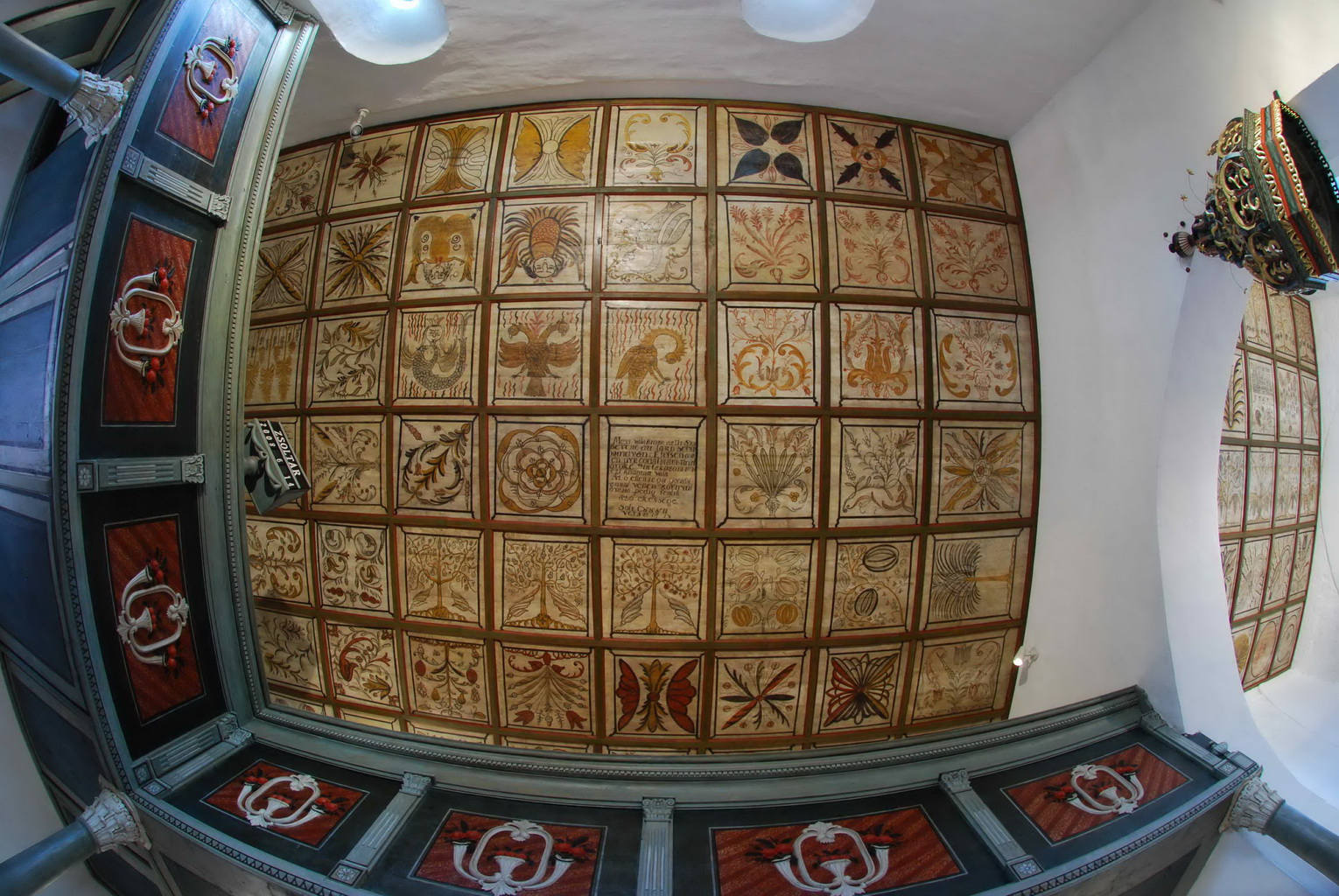 |
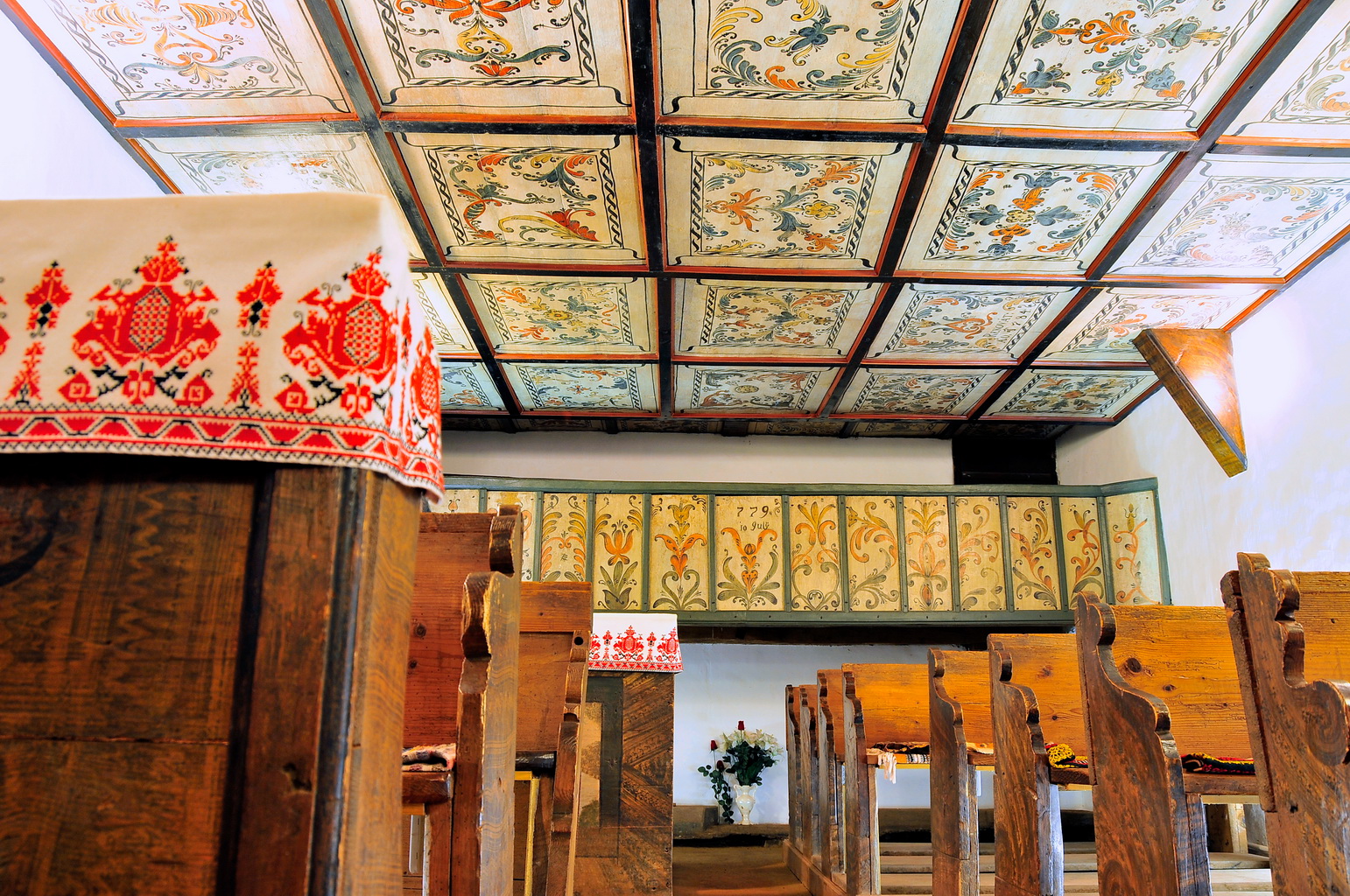 |
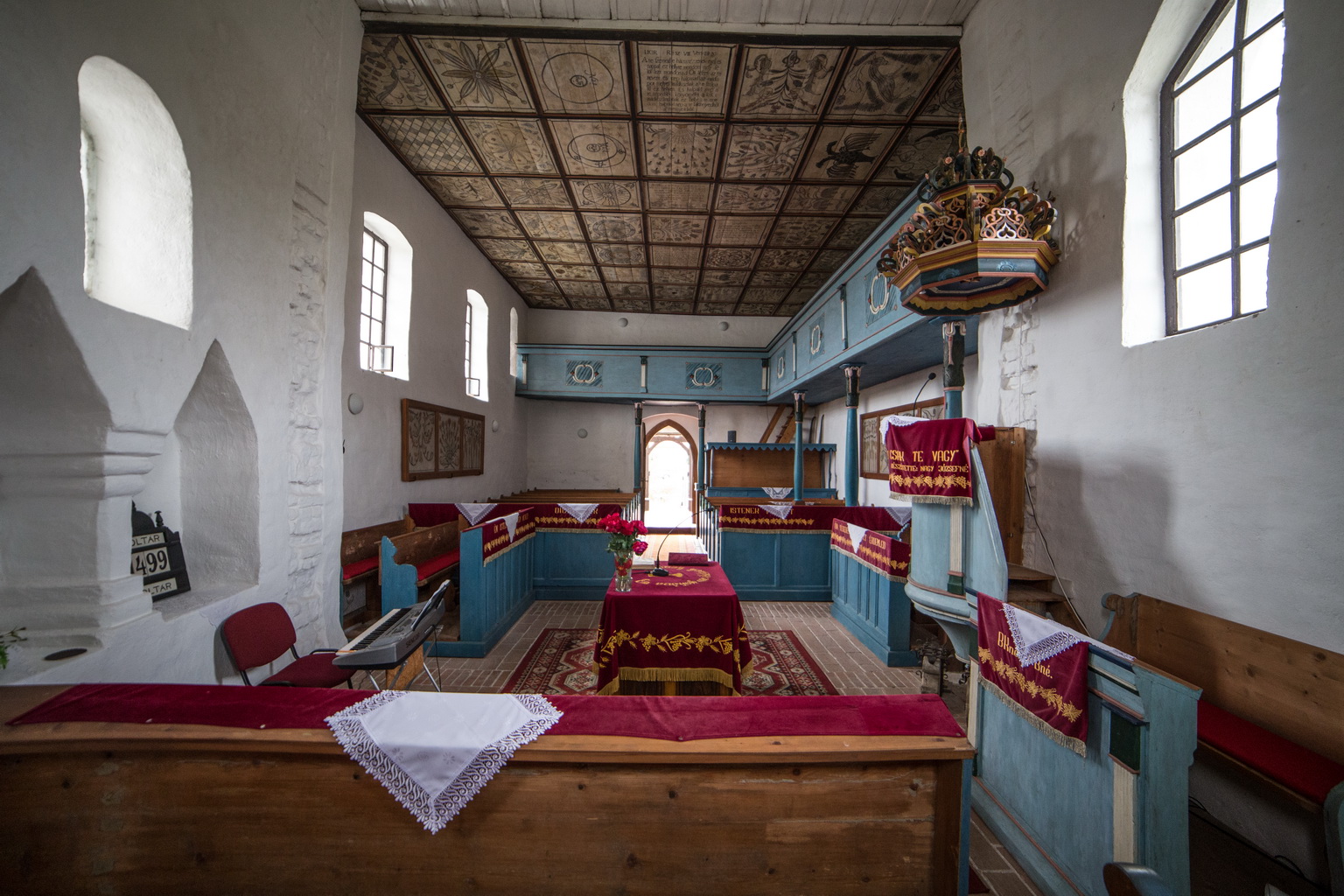 |
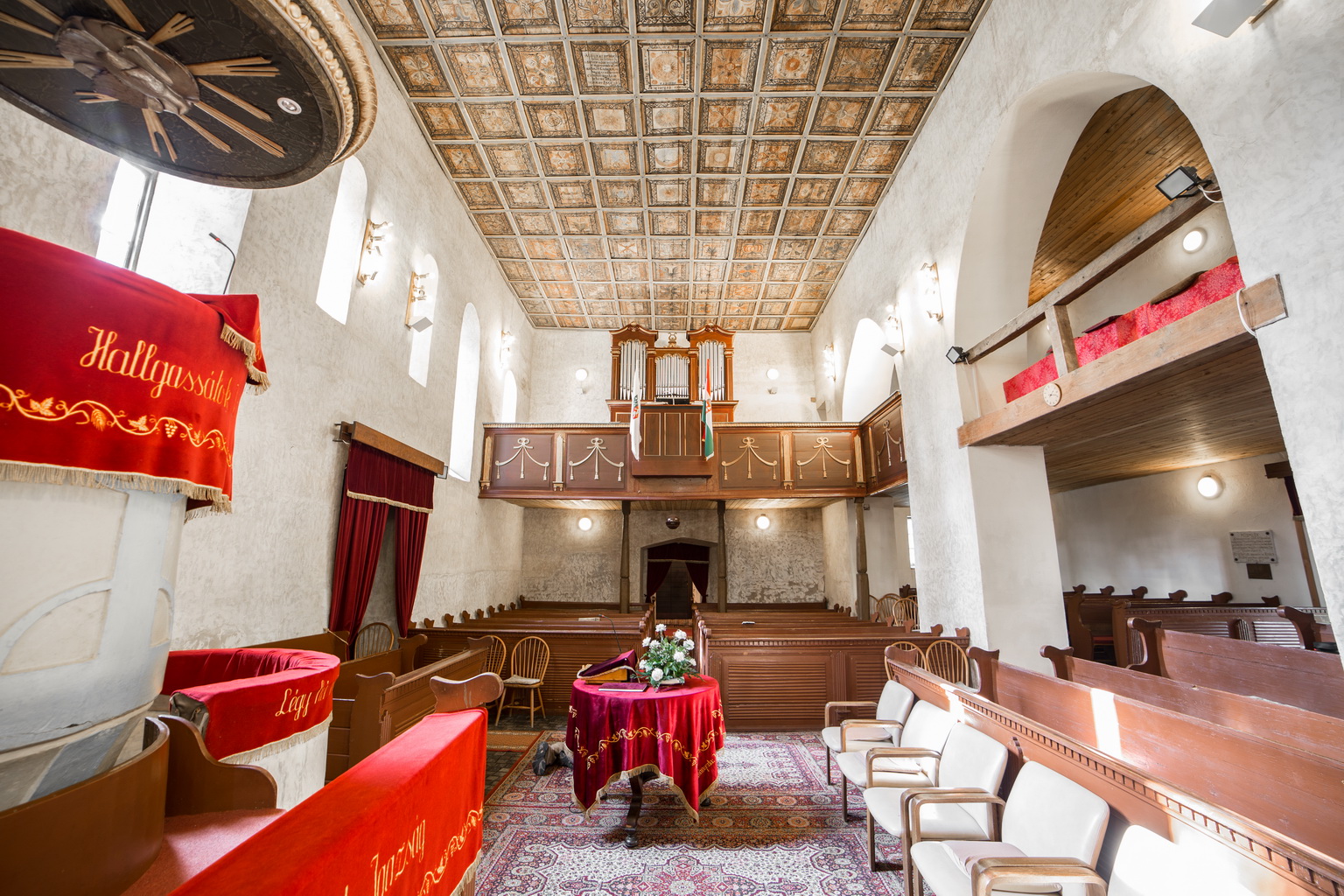 |
|
Gyügye |
Tákos |
Csengersima |
Csenger |
.jpg) |
|
Sonkád |
The painted wooden ceiling: Reformed or not?
The painted wooden ceilings are considered to be the characteristic features of the Reformed churches. It is partly true since wooden ceilings have only been preserved in Reformed churches (in some cases, in Unitarian or Evangelical churches), but it does not mean that the Catholic churches did not feature them. Following the expulsion of the Turks, the collapsed vaults were not restored during the reconstruction processes, instead, simple wooden ceilings were created, which were decorated with paintings by both the Reformed and the Catholic. During the 18th century, the churches of the Catholics were reconstructed. On the site of the small medieval churches, large, baroque churches were erected, which featured vaults, and frescos on the vaults. Even though the Protestant denominations were always much poorer, they managed to preserve their old churches. However, the fact that the wooden ceilings can be adored today is not only due to poverty, but rather to the respect that they have shown to their ancestors in addition to their care and thoughtfulness.
With or without pictures?
“There have always been, and I have no doubt that there will always be people who, when seeing the church with no pictures of idols and altars, said and will say it is inglorious and harmful. As the altars full of pictures are considered to be valuable to the churches by many people, and without them they are barren.” A sermon from Abraham Scultetus.
The churches of the Reformed appear to be simple and ornamentless, compared to the Catholic or Orthodox churches, which are rich in pictures and sculptures. The Reformed returned to the Law of Moses and rejected the use of painted and carved pictures, as they were considered idolatry. As a result, they cleared their churches of the old pictures.
But what exactly does the Reformed prohibition of pictures mean? Where does this tradition originate? Do their churches really feature no pictures?
The idea spread in the Reformed Church and has its origin in the teachings of John Calvin (1509-1564), 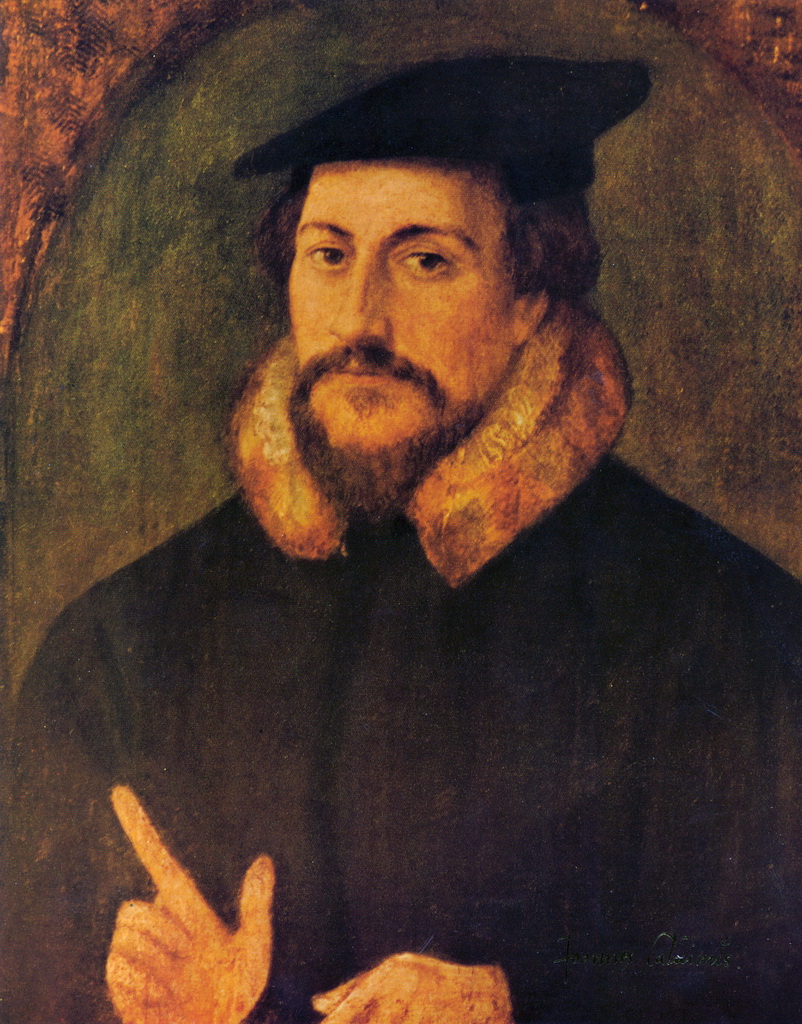 who said that God was impossible to be depicted, as He was invisible. God could not be sensed by the eyes, only by hearing through His words and acts written in the Bible. Accordingly, the church must be the school of God where instead of the misleading pictures, the teachings of the Holy Bible should be considered by the congregation. Christ is also impossible to be depicted as “no person lives in this world who could have seen Him; and it originates from this fact that some paint a yellow color, some paint a chestnut brown color and some paint a black color beard on Him”.
who said that God was impossible to be depicted, as He was invisible. God could not be sensed by the eyes, only by hearing through His words and acts written in the Bible. Accordingly, the church must be the school of God where instead of the misleading pictures, the teachings of the Holy Bible should be considered by the congregation. Christ is also impossible to be depicted as “no person lives in this world who could have seen Him; and it originates from this fact that some paint a yellow color, some paint a chestnut brown color and some paint a black color beard on Him”.
Although the pictures of the saints had no place in Reformed churches, they did not resign the ornamentation of the congregation houses, as the most important places of community life. A beautiful example of this is the church of Sonkád, which differed, and differs today, from the houses of the common people in that each of its sections is color painted, and each item of its furnishings is finely carved. In conclusion, the Reformation did not exclude art from the churches. Rather, it let art unfold in a different way, the way of ornamentalism. (Sometimes, even the placement of pictures was allowed in the churches, but let’s not run forward so fast!)
The continuation of the old tradition prior to the Reformation is the painted ornamentation of the interior and exterior walls, 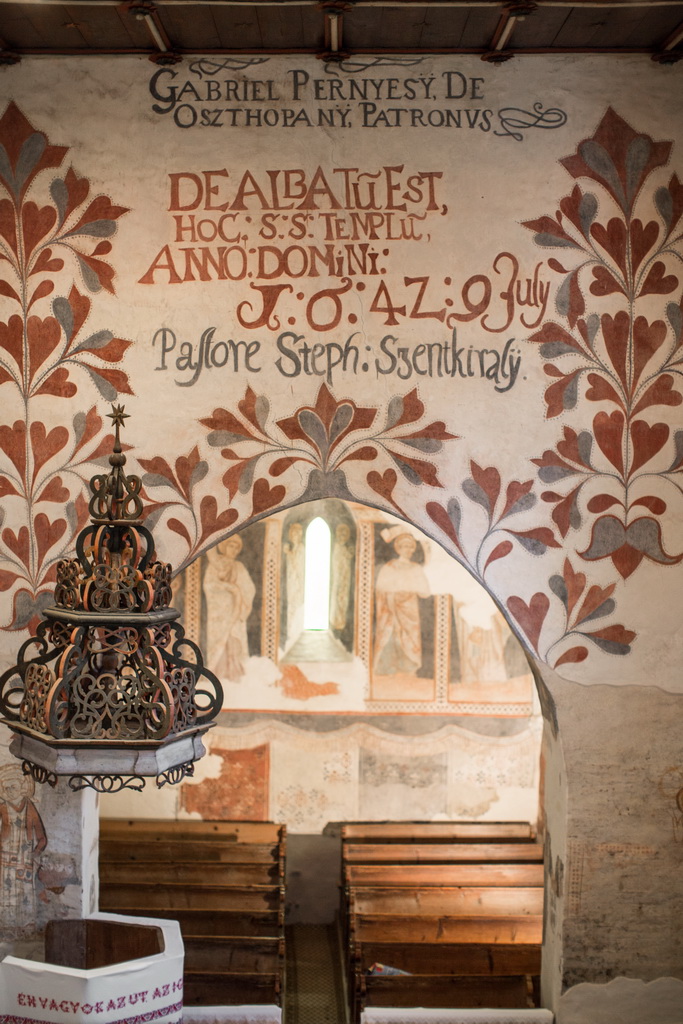
The Reformed replaced the pictures depicting the stories of the saints with symbols, but more frequently with the writing itself. Regrettably, only two frames refer to the fact that the walls of the sanctuary featured writings in Sonkád - probably, quotations from the Bible referring to the Lord’s Supper.
Another important element of Protestant churches is the writing of creation featuring the names of those involved in the decoration and the maintenance activities of the house of God in addition to the date of decoration.
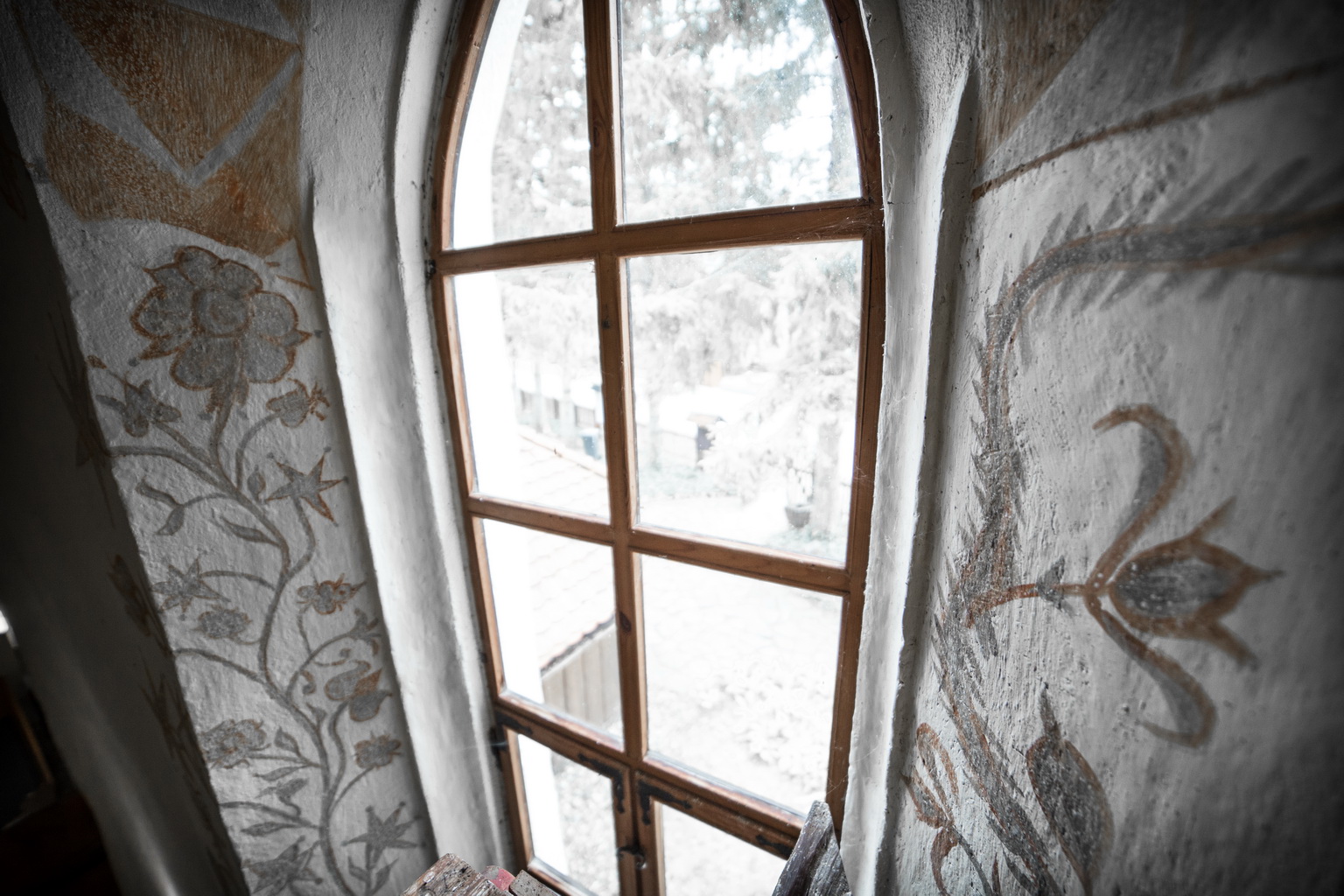 |
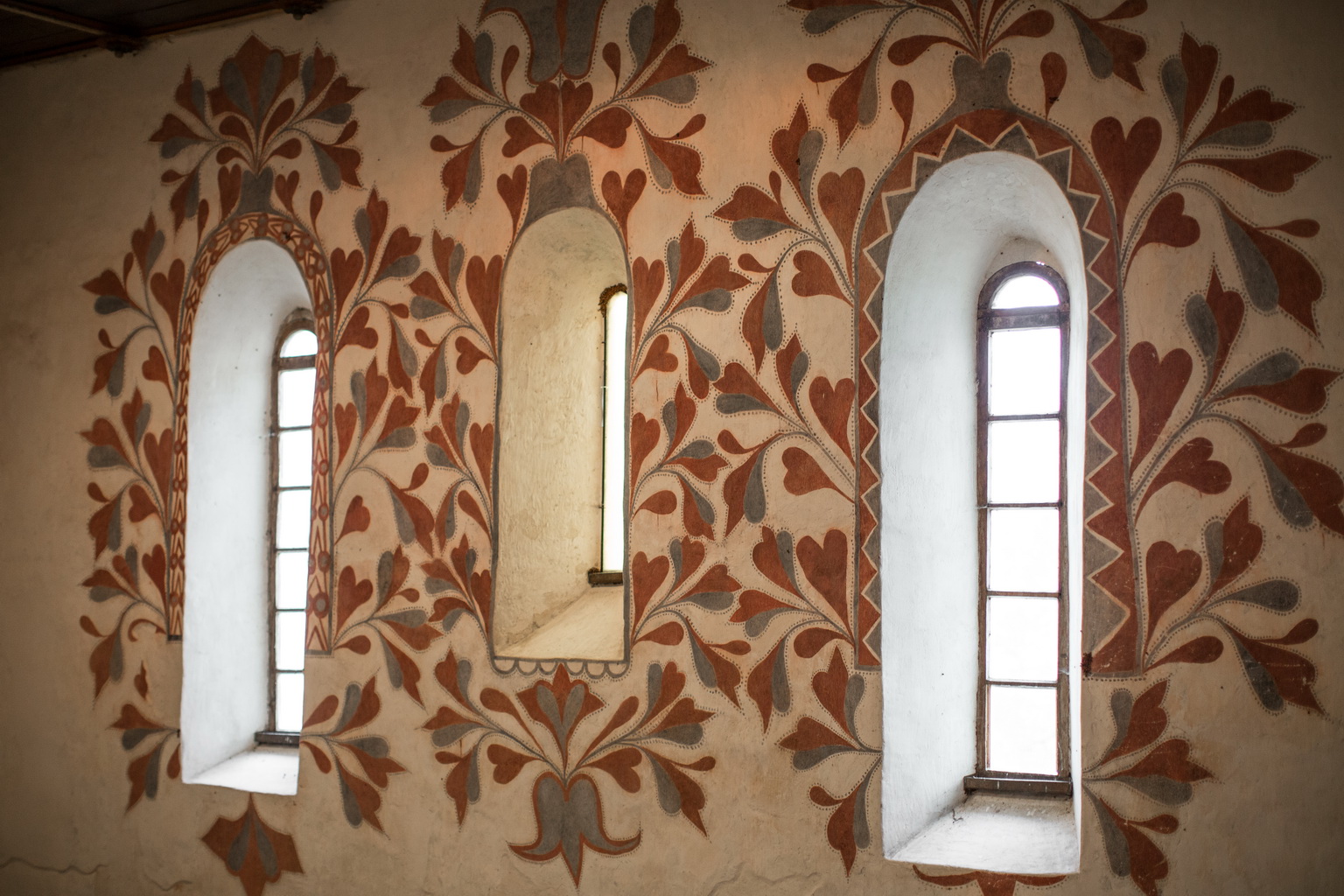 |
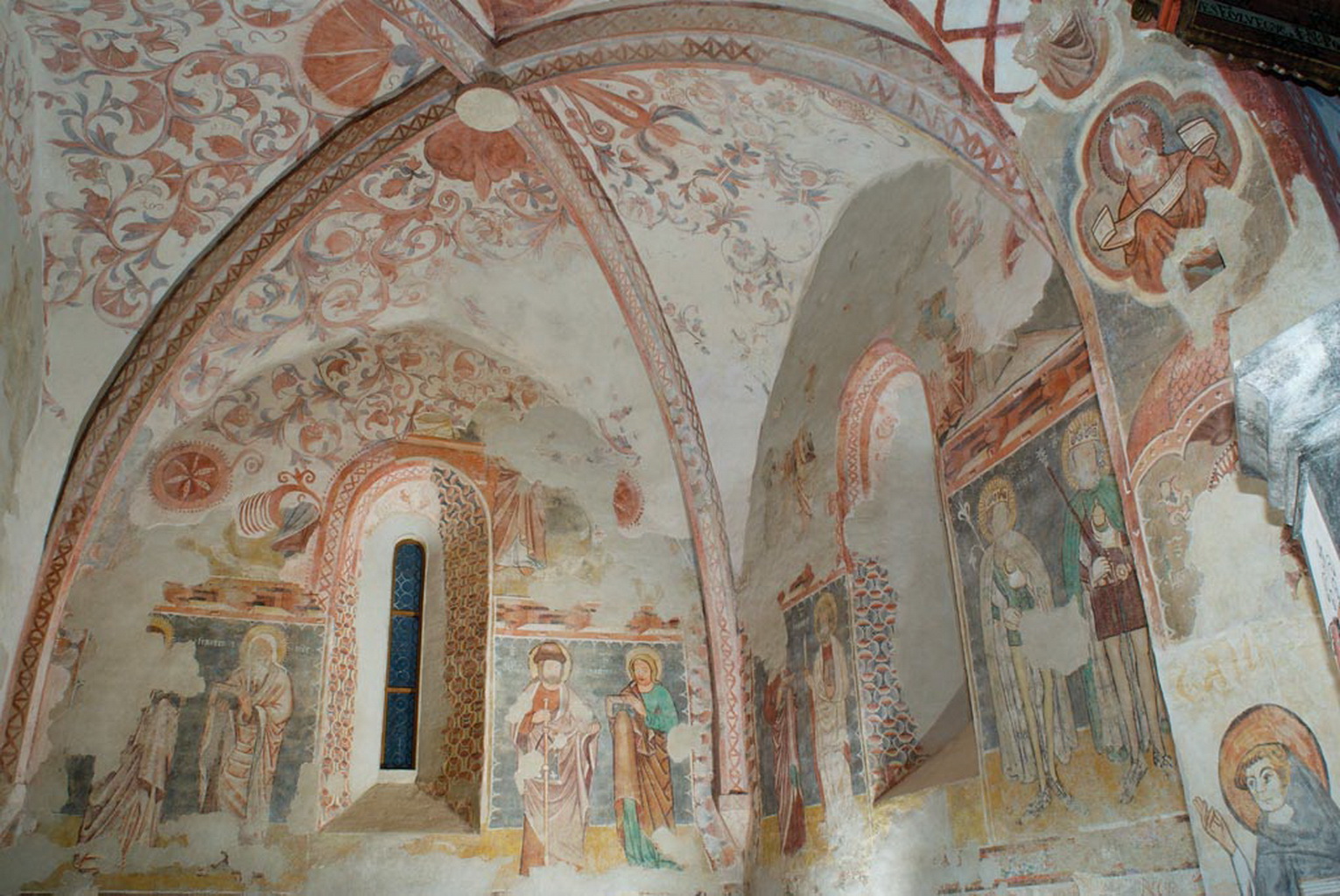 |
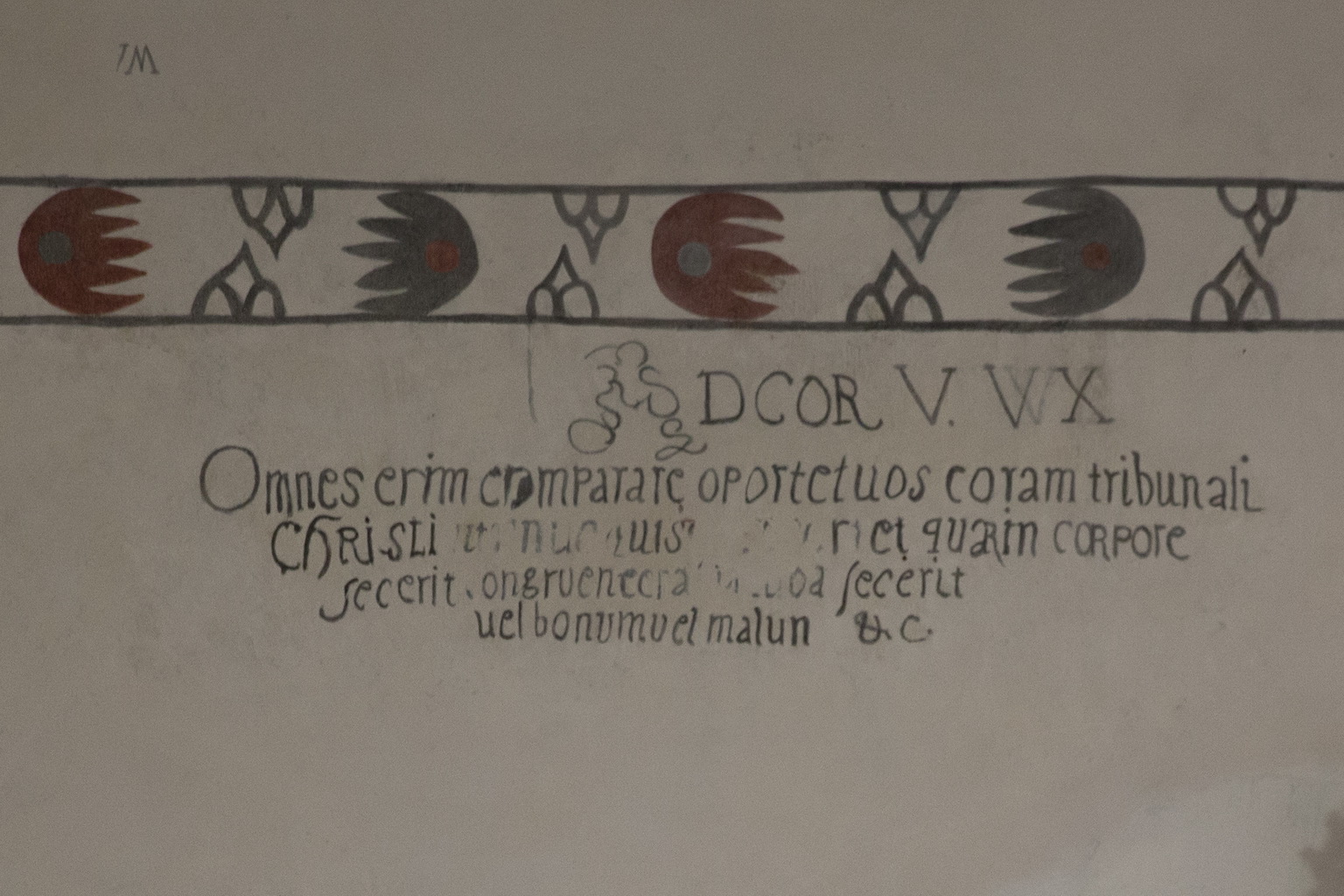 |
|
Sonkád |
Csaroda |
Lónya |
Vámosoroszi |
